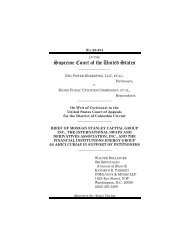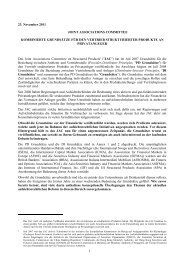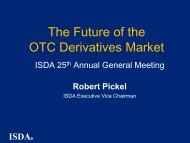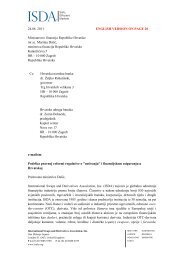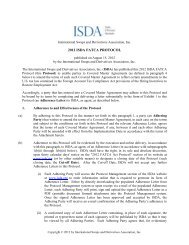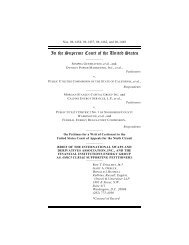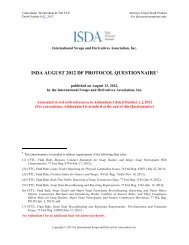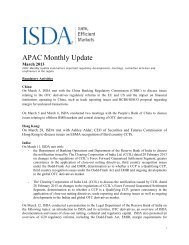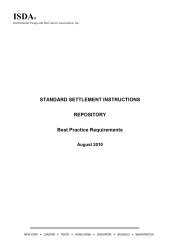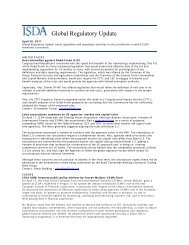ISDA Margin Survey 2013
ISDA Margin Survey 2013
ISDA Margin Survey 2013
You also want an ePaper? Increase the reach of your titles
YUMPU automatically turns print PDFs into web optimized ePapers that Google loves.
2. COLLATERAL ASSETS<br />
6<br />
2.1. ESTIMATES OF TOTAL COLLATERAL OUTSTANDING FOR NON-CLEARED OTC TRANSACTIONS<br />
The reported amount of collateral in circulation, the collateral balances held or posted that have been received<br />
or delivered (respectively) by two counterparts to an OTC derivatives contract, in the non-cleared OTC<br />
derivatives market at the end of 2012 was approximately $2.67 trillion, which is up over 8 percent from last<br />
year's estimated amount of $2.46 trillion. Collateral in circulation is the total collateral received and delivered<br />
against non-centrally cleared transactions and is a useful indicator of the total amount of collateral used to<br />
mitigate the credit risk of OTC derivatives.<br />
The $3.7 trillion estimate of total collateral in circulation is based on a total reported collateral amount of $2.67<br />
trillion; the estimation procedure to derive the collateral in circulation value from the reported collateral<br />
amount is described in Appendix 2. Measured over the past 14 years, the growth in estimated collateral in<br />
circulation has remained relatively consistent, resulting in a compound annual growth rate of 23 percent.<br />
It is interesting to note that the overall level of collateral in circulation has remained essentially static year on<br />
year, even though more business is now being cleared, and is thus excluded from the results reported here,<br />
suggesting continued underlying growth in the collateralization of bilateral OTC derivatives. Additionally, the<br />
levels of bilaterally compressed transactions continued on a regular basis through 2012 with more than $48.7<br />
trillion in Interest Rate Derivatives and Credit Derivatives compressed on a net basis 2 . Compression involves the<br />
tearing up of matched trades or trades that do not contribute risk to a dealer’s portfolio. In recent years, the<br />
large volume of cleared trades that have been compressed has worked to reduce the percentage of the OTC<br />
derivatives market that has been cleared. As with IRS, compression of cleared CDS trades leads to a significant<br />
reduction in the percent of CDS that remain open in a cleared state. <strong>ISDA</strong> believes that this effect has been<br />
particularly dramatic in the CDS space as the instruments have become completely standardized following the<br />
Big Bang and Small Bang protocols in 2009, and thus are able to be compressed very efficiently. Furthermore,<br />
clearinghouses that clear CDS have an active program of compressing cleared trades. For example, ICE reports<br />
that the gross notional amount of transactions cleared from the commencement of clearing in 2009 through<br />
June 29, 2012, is approximately $31.2 trillion. If compression had not occurred, <strong>ISDA</strong> estimates that a<br />
significantly greater percentage of CDS would continue to exist in clearinghouses, increasing the percentage of<br />
the market that is cleared. For CDS, compression continues to reduce operational risk and enables more efficient<br />
management of capital requirements 3 .<br />
2 Sources: TriOptima, Markit/ICE<br />
3 Source: <strong>ISDA</strong> Mid-Year 2012 Market Analysis<br />
<strong>ISDA</strong> <strong>Margin</strong> <strong>Survey</strong> <strong>2013</strong> June <strong>2013</strong>



